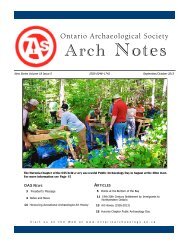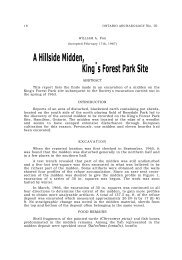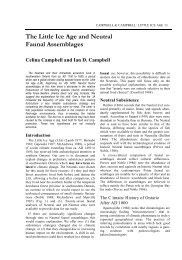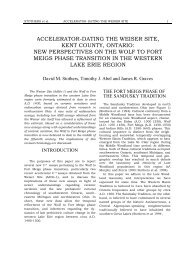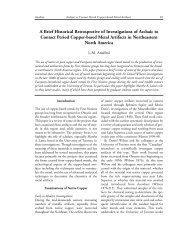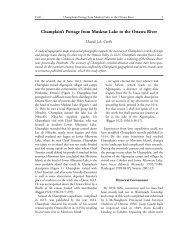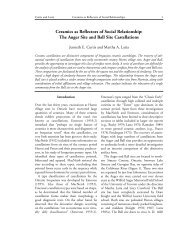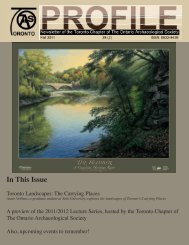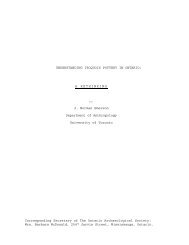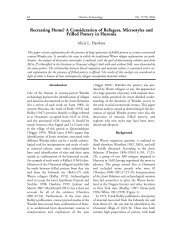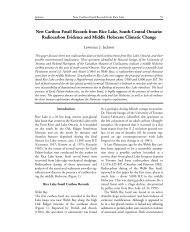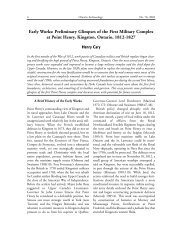Huron-St. Lawrence Iroquois Relations in the Terminal Prehistoric ...
Huron-St. Lawrence Iroquois Relations in the Terminal Prehistoric ...
Huron-St. Lawrence Iroquois Relations in the Terminal Prehistoric ...
You also want an ePaper? Increase the reach of your titles
YUMPU automatically turns print PDFs into web optimized ePapers that Google loves.
24 ONTARIO ARCHAEOLOGY NO. 44auspices of <strong>the</strong> New York Historical Society and<strong>the</strong> Smithsonian Institution. He published <strong>the</strong>results of this survey twice, first with <strong>the</strong> SmithsonianInstitution <strong>the</strong>n commercially <strong>in</strong> Buffalo(Squire 1851a:17-26; 1851b). In 1850 and aga<strong>in</strong> <strong>in</strong>1851 Frankl<strong>in</strong> B. Hough published short papers <strong>in</strong>which he noted <strong>the</strong> locations and nature of sites <strong>in</strong>Jefferson County and described some pottery andpipes from <strong>the</strong>se sites (Hough 1850:100-105;1851:103-109). In 1854 Hough re-published muchof this <strong>in</strong>formation <strong>in</strong> his History of JeffersonCounty (1854:10-13). The Jefferson CountyHistorical Society published a booklet <strong>in</strong> 1895which <strong>in</strong>cludes a paper by Henry Woodworth thatnotes <strong>the</strong> presence of archaeological sites <strong>in</strong> generalterms. In 1898 Edgar C. Emerson published hiswork on Jefferson County <strong>in</strong> which he noted <strong>the</strong>location of many archaeological sites us<strong>in</strong>g a seriesof sketch maps. In 1900 William M. Beauchamppublished an <strong>in</strong>ventory of <strong>the</strong> archaeological sites<strong>in</strong> <strong>the</strong> County.But it was not until 1906, when a PeabodyMuseum field party under M.R. Harr<strong>in</strong>gton excavatedon fourteen <strong>Iroquois</strong> sites, that a record of<strong>the</strong> <strong>Iroquois</strong> material culture from Jefferson Countybecame available. Harr<strong>in</strong>gton reported on thirteenof <strong>the</strong>se sites <strong>in</strong> his paper <strong>Prehistoric</strong> <strong>Iroquois</strong> Sites<strong>in</strong> Nor<strong>the</strong>rn New York (1922) but a more detailedaccount of his work on <strong>the</strong> Putnam site rema<strong>in</strong>sunpublished (Harr<strong>in</strong>gton n.d.). In 1922 Arthur C.Parker published a catalogue of archaeological sites<strong>in</strong> New York <strong>St</strong>ate which <strong>in</strong>cludes those <strong>in</strong>Jefferson County. This work was largely derivedfrom Beauchamp's earlier <strong>in</strong>ventory. William A.Ritchie visited <strong>Iroquois</strong> sites <strong>in</strong> Jefferson Countybut he did not publish an account of his work <strong>the</strong>re(Funk 1977).In 1966 Robert Weber, a graduate student at <strong>the</strong><strong>St</strong>ate University of New York at Buffalo(SUNYAB) surveyed <strong>the</strong> Sandy Creek dra<strong>in</strong>ageand <strong>the</strong> Watertown area. He succeeded <strong>in</strong> locat<strong>in</strong>gseventeen of <strong>the</strong> sites recorded <strong>in</strong> <strong>the</strong> early literature(Weber 1968; White n.d.a:l).In 1967 a Highway Salvage Survey Team fromSUNYAB surveyed areas <strong>in</strong> Jefferson County and<strong>the</strong> Durham site <strong>in</strong> particular. In part due to <strong>the</strong>success of this work, Marian White formulated aresearch proposal entitled "The Nature of Warfareand Confederacies among <strong>the</strong> Nor<strong>the</strong>rn <strong>Iroquois</strong>"and <strong>in</strong> 1968 conducted <strong>the</strong> SUNYAB SummerSchool which located some twenty sites <strong>in</strong> <strong>the</strong>Sandy Creek dra<strong>in</strong>age. Excavations were conductedon eight sites <strong>in</strong>clud<strong>in</strong>g <strong>the</strong> Durham siteaga<strong>in</strong>. In 1969 <strong>the</strong> SUNYAB Summer Field Schoolundertook a major excavation on <strong>the</strong> Durham site(Sidler 1971). Plans to cont<strong>in</strong>ue work by SUNYAB<strong>in</strong> Jefferson County were term<strong>in</strong>ated by Dr. White'suntimely death.Over <strong>the</strong> past decade excavations have been conductedon a number of <strong>St</strong>. <strong>Lawrence</strong> <strong>Iroquois</strong> sites<strong>in</strong> Jefferson County. Marjorie Burger and PeterPratt have excavated on <strong>the</strong> Camp Drum 1 site;Peter Miller of SUNY at Potsdam on <strong>the</strong> Depauvillesite and <strong>the</strong> late Merill Waters of Water-town, NewYork on <strong>the</strong> Frank site near Dexter. Earl Sidlerconducted a field school on <strong>the</strong> Carlos site and on<strong>the</strong> Morse site. He also excavated on <strong>the</strong> Potockisite. Accounts of this work have not beenpublished.The long and varied history of <strong>Iroquois</strong> archaeologicalsites <strong>in</strong> Jefferson County is characterized by<strong>the</strong>ir hav<strong>in</strong>g been ravaged by collectors from farand wide. Large collections remarked upon <strong>in</strong> <strong>the</strong>19th century for <strong>the</strong>ir sophisticated artifacts can nolonger be located. Tales of collectors who saved onlypipes and those who only saved reconstructedpottery rims are still recounted. Apart from <strong>the</strong> JackCarter collection at Clayton, <strong>the</strong> Merill Waters collection<strong>in</strong> Watertown and a few o<strong>the</strong>rs which providereliable provenance, no private collectionshave survived for study.The literature suggests <strong>the</strong>re were some sixty-odd<strong>Iroquois</strong> sites <strong>in</strong> <strong>the</strong> County, nearly double that <strong>in</strong>nearby Ontario and Quebec. However this estimateshould be noted with reservations. There has notbeen a comprehensive archaeological survey of <strong>the</strong>County and current site list<strong>in</strong>gs are flawed by <strong>the</strong>many names by which some sites have been knownover <strong>the</strong> years. The earlier Algonqu<strong>in</strong>-<strong>Iroquois</strong>dichotomy by which sites <strong>in</strong> <strong>the</strong> County wereclassified also cont<strong>in</strong>ues to conceal some early<strong>Iroquois</strong> sites.European MaterialAlthough extensive and at times exhaustive digg<strong>in</strong>ghas been carried on <strong>in</strong> Jefferson County s<strong>in</strong>ceat least 1849, not one article of European orig<strong>in</strong> hasbeen excavated <strong>in</strong> an archaeological context whichpermits it to be attributed to <strong>the</strong> <strong>St</strong>. <strong>Lawrence</strong><strong>Iroquois</strong>.However, European material has been found onor near <strong>Iroquois</strong> sites. In 1802 Taylor observed:"The po<strong>in</strong>t of a steel sword — 2 edges — about afoot long, was found last spr<strong>in</strong>g <strong>in</strong> plough<strong>in</strong>g <strong>in</strong> <strong>the</strong>fort [embankment] located on <strong>the</strong> south branch ofSandy Creek" (1850:1139). Hough (1854:11),Beauchamp (1886:66) and Edgar Emerson(1898:576) repeat this account of <strong>the</strong> f<strong>in</strong>d atEllisburg without add<strong>in</strong>g details. Hough andEmerson also mention how musket balls, hatchetsand knives have been found <strong>in</strong> <strong>the</strong> County attribut<strong>in</strong>g<strong>the</strong>m to <strong>the</strong> presence of <strong>the</strong> French and English<strong>in</strong> <strong>the</strong> 17th century and later. Emerson also notesthat a star-shaped silver ornament with <strong>the</strong> <strong>in</strong>itials'P.H.' was found <strong>in</strong> Adams Township near Sandy



